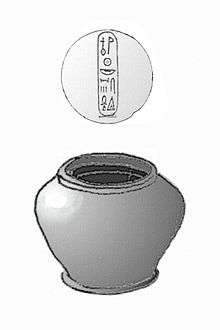Nebsenre
| Nebsenre | |||||||||||||||||
|---|---|---|---|---|---|---|---|---|---|---|---|---|---|---|---|---|---|
| Ranebsen | |||||||||||||||||
 Small jar and jar lid with cartouche of Nebsenre | |||||||||||||||||
| Pharaoh | |||||||||||||||||
| Reign | at least 5 months in the first half of the 17th century BCE (14th Dynasty) | ||||||||||||||||
| Predecessor | Heribre | ||||||||||||||||
| Successor | unknown | ||||||||||||||||
| |||||||||||||||||
Nebsenre (meaning "Their Lord is Ra"[1]) was an Egyptian pharaoh of the 14th Dynasty of Egypt during the Second Intermediate Period. Nebsenre reigned for a least five months over the Eastern and possibly Western Nile Delta, some time during the first half of the 17th century BCE.[3] As such Nebsenre was a contemporary of the Memphis based 13th Dynasty.
Attestations
Historical source
The prenomen "Nebsenre" is preserved on the ninth column, 14th row[note 1] of the Turin canon, a list of kings written during the reign of Ramses II (1279–1213 BCE) which serves as the primary historical source for the Second Intermediate Period.[5] The canon further credits Nebsenre with a lost number of years, five months and 20 days of reign following Heribre on the throne.[6] The prenomen of Nebsenre's successor is written as wsf on the Turin king list,[6][7] indicating that his name was already lost in a lacuna of the document from which the canon was copied in Ramesside times.[8]
Contemporary artefact
Nebsenre is one of only four[9] kings of the 14th Dynasty to be attested by an artefact contemporary with his reign: a jar of unknown provenance bearing his prenomen, which was in the private Michailidis collection.[10][4]
Chronological position
According to the Egyptologists Kim Ryholt and Darrell Baker, Nebsenre was the 14th king of the 14th Dynasty,[11] a line of rulers of Canaanite descent reigning over the Eastern Nile Delta from c. 1700 BCE until c. 1650 BCE.[note 2] Alternatively the Egyptologist Jürgen von Beckerath sees him as the fifteenth ruler, due to a differing reconstruction of the early 14th Dynasty.[14]
Notes
- ↑ Following Ryholt's reconstruction of the Turin canon. This corresponds to the eighth column, fourteenth row in the reconstruction of the canon of Gardiner and von Beckerath.[4]
- ↑ Ryholt dates the beginning of the 14th Dynasty to c. 1800 BCE,[3] adding five kings to it before Nehesy. This is rejected by most Egyptologists who consider Nehesy to have been either the founder[12] or the second king of the dynasty.[13]
References
- 1 2 Leprohon 2013, p. 205.
- ↑ Baker 2008, pp. 247–248.
- 1 2 Ryholt 1997, p. 409.
- 1 2 Baker 2008, p. 248.
- ↑ Ryholt 1997, pp. 9–18.
- 1 2 Ryholt 1997, p. 198.
- ↑ Ryholt 2012, p. 31.
- ↑ Ryholt 1997, p. 10–11.
- ↑ Bourriau 2003, p. 178.
- ↑ Kaplony 1973, p. 15, pl. 10, 23 [Cat. 41].
- ↑ Ryholt 1997, p. 98.
- ↑ Quirke 2001, p. 261.
- ↑ von Beckerath 1999, pp. 108–109, king 2.
- ↑ von Beckerath 1999, pp. 108–109, king 15.
Bibliography
- Baker, Darrell D. (2008). The Encyclopedia of the Egyptian Pharaohs. Volume I: Predynastic to the Twentieth Dynasty (3300–1069 BC). London: Bannerstone Press. ISBN 978-1-905299-37-9.
- Bourriau, Janine (2003). "The Second Intermediate Period (c. 1650–1550 BC)". In Shaw, Ian. The Oxford History of Ancient Egypt (new ed.). Oxford: Oxford University Press. ISBN 978-0-19-280458-7.
- Kaplony, Peter (1973). Beschriftete Kleinfunde in der Sammlung Georges Michailidis: Ergebnisse einer Bestandsaufnahme im Sommer 1968. Uitgaven van het Nederlands Historisch-Archaeologisch Instituut te İstanbul, 32. Istanbul: Nederlands Historisch-Archeologisch Instituut in het Nabije Oosten. OCLC 1064212.
- Leprohon, Ronald J. (2013). The great name: ancient Egyptian royal titulary. Writings from the ancient world, no. 33. Atlanta: Society of Biblical Literature. ISBN 978-1-58-983736-2.
- Quirke, Stephen (2001). "Second Intermediate Period". In Redford, Donald B. The Oxford Encyclopedia of Ancient Egypt, Volume 3. Oxford University Press. pp. 260–265. ISBN 978-0-19-510234-5.
- Ryholt, Kim (1997). The Political Situation in Egypt during the Second Intermediate Period, c. 1800–1550 B.C. CNI publications, 20. Carsten Niebuhr Institute of Near Eastern Studies, University of Copenhagen : Museum Tusculanum Press. ISBN 978-87-7289-421-8.
- Ryholt, Kim (2012). "The Royal Canon of Turin". In Hornung, Erik; Krauss, Rolf; Warburton, David. Ancient Egyptian Chronology. Handbook of Oriental Studies. Leiden, Boston: Brill. pp. 26–32. ISBN 978-90-04-11385-5. ISSN 0169-9423.
- von Beckerath, Jürgen (1999). Handbuch der ägyptischen Königsnamen (in German). Münchner ägyptologische Studien, Heft 49, Mainz : Philip von Zabern. ISBN 978-3-8053-2591-2.
| Preceded by Heribre |
Pharaoh of Egypt Fourteenth Dynasty |
Succeeded by unknown |